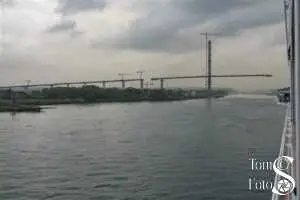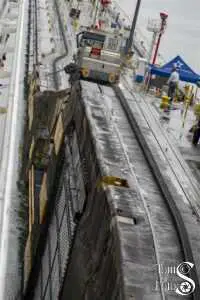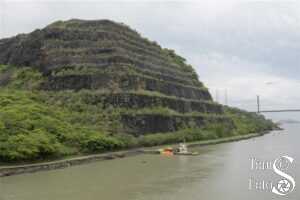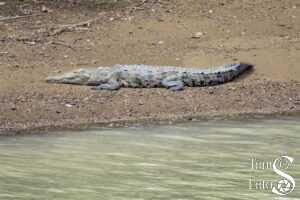We are now in the Pacific Ocean heading north after a 12 hour transit of the Panama Canal. I even have a certificate to prove it. 🙂
The alarm went off at 5:45am and I was out on the balcony by 6:00am as the sun was rising. We never saw it all day as it was behind clouds but none-the-less it was still quite hot and humid with just a little rain on us; plenty elsewhere we could see. When I got out we had just started moving into the canal so I do have photos of the entrance even though they are looking backward instead of forward.
The Gatun Locks are the first set of locks that you come to shortly after entering the canal from the Atlantic side. Before you get to them however you cross under the Bridge of the Atlantic which is currently under construction and due to open in 2019 (see photo 1).
The Gatun Lock is a triple lock. There are three in-line locks to rise to the level of Gatun Lake and you move from one to the next as you continue forward. The Panama Canal locks are more complicated than the locks we encountered on the Columbia River last year. For those locks you just tied the boat to a sliding post and rode the water up or down. In these locks you also ride the water up or down but as the ships are quite a bit larger and can do much damage if they hit the sides of the lock it’s important to keep them centered. In these locks “mules” are used to keep the ship in the center of the lock. The mules are simplified railroad locomotives that move along a cog railway running along the side of the lock. Our ship had four mules; two on one side and two on the other. Larger ships had six. The mules made the cables connecting them to the ship tight on both sides and that worked to keep the ship in the center of the lock. Since the locks change the water level height the mule tracks have to change levels as well. See photo 2 to see this.
At the top of the lock we sailed into Gatun Lake and, after a short delay for scheduling purposes, we started the transit of the lake. Gatun Lake is a man-made lake created by dams on local rivers. The lake is central to the operation of the canal. Water flows into the locks from the lake and is released into the oceans on either side of the isthmus we are moving across. If the water source(s) ever dry up the Panama Canal would no longer work and traffic would again have to flow around South America.
After a few hours crossing the lake we entered a section of the canal that had to be excavated. The rocks in Panama are hard and the canal was not so much dug as detonated. TNT was used to break up the rocks and then the loosened rocks were carried away. Many cuts were made to create the canal and they all used this technique. The hardest cut to make is toward the middle of the canal and you can see it in photo 3 below. The edges of the cut have also been stabilized with rock bolts.
During the transit we looked hard for various animals that live in the area. I saw several birds but was in the cabin when the Captain announced a spotting on the port side of the ship. Grabbed the camera, went out on the balcony, and got photo number 4. I was delighted to be able to do that and was hoping we would see a crocodile on our transit. I also have photos of different birds including one carrying something it picked up out of the water. But, you’ll have to come to the Photo Club to see that (this section of the cruise is tentatively scheduled for December, after I return from the North Pacific cruise mid-September to mid-November).
On the Pacific side of the canal you first encounter a single lock called Pedro Miguel followed shortly by the double Miraflores Lock. So, three up and three down brings you back to sea level. Passage under the Bridge of Americas brought us to the Pacific Ocean and the end of the canal.
In general, it was hard to photograph passage through the locks as we used the older locks instead of the new and tended to fill the lock with the ship. Fortunately, the locks are double; side by side identical locks. A cargo ship followed us through some of the locks and used the second side. We would go into the right lock and it would go into the left some time later. This gave me the opportunity to photograph the action in the cargo ship side and be able to say that we were doing something similar on our side.
I can now cross another item off my bucket list: passage through both the Suez and Panama canals.
Pardon me now as I have to go to bed. It’s been a hot day and I am beat. Amazing how much just heat and humidity can take out of you. Add to that multiple times up and down the stairs and back and forth from side to side on the upper deck and I’m ready to sleep.



